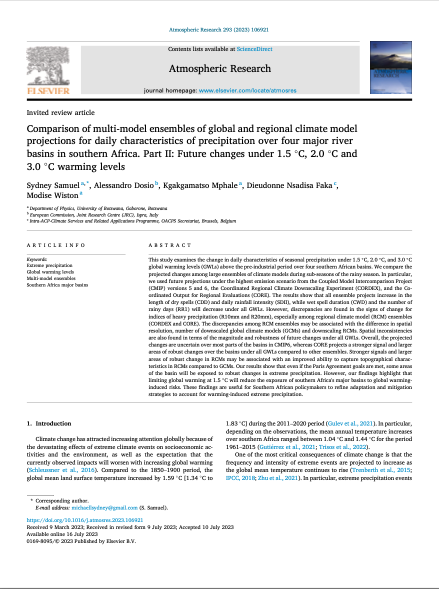Download the full PDF

This study examines the change in daily characteristics of seasonal precipitation under 1.5 ◦C, 2.0 ◦C, and 3.0 ◦C global warming levels (GWLs) above the pre-industrial period over four southern African basins. We compare the projected changes among large ensembles of climate models during sub-seasons of the rainy season. In particular, we used future projections under the highest emission scenario from the Coupled Model Intercomparison Project (CMIP) versions 5 and 6, the Coordinated Regional Climate Downscaling Experiment (CORDEX), and the Coordinated Output for Regional Evaluations (CORE). The results show that all ensemble projects increase in the length of dry spells (CDD) and daily rainfall intensity (SDII), while wet spell duration (CWD) and the number of rainy days (RR1) will decrease under all GWLs.
However, discrepancies are found in the signs of change for indices of heavy precipitation (R10mm and R20mm), especially among regional climate model (RCM) ensembles (CORDEX and CORE). The discrepancies among RCM ensembles may be associated with the difference in spatial resolution, number of downscaled global climate models (GCMs) and downscaling RCMs. Spatial inconsistencies are also found in terms of the magnitude and robustness of future changes under all GWLs. Overall, the projected changes are uncertain over most parts of the basins in CMIP6, whereas CORE projects a stronger signal and larger areas of robust changes over the basins under all GWLs compared to other ensembles.
Stronger signals and larger areas of robust change in RCMs may be associated with an improved ability to capture topographical characteristics in RCMs compared to GCMs. Our results show that even if the Paris Agreement goals are met, some areas of the basin will be exposed to robust changes in extreme precipitation. However, our findings highlight that limiting global warming at 1.5 ◦C will reduce the exposure of southern Africa's major basins to global warminginduced risks. These findings are useful for Southern African policymakers to refine adaptation and mitigation strategies to account for warming-induced extreme precipitation.